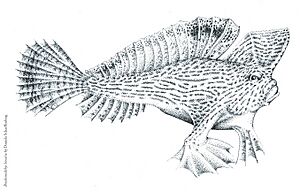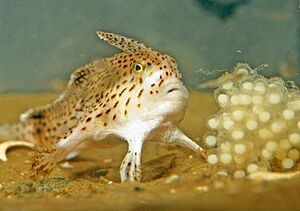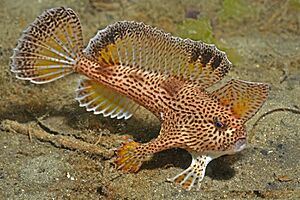Spotted handfish facts for kids
Quick facts for kids Spotted handfish |
|
|---|---|
 |
|
| Conservation status | |
| Scientific classification | |
| Synonyms | |
|
The spotted handfish (Brachionichthys hirsutus) is a very rare Australian fish. It belongs to the handfish family, which is special because these fish use their fins like hands to "walk" on the seafloor. This unique fish is critically endangered, meaning it's at high risk of disappearing forever. It lives only in the estuary of the Derwent River in Tasmania, Australia. The biggest threat to its survival is an invasive species called the Northern Pacific seastar.
About the Spotted Handfish
The spotted handfish is a unique type of anglerfish. It is one of the few fish families found only in Australia. These fish are small, usually growing up to about 12 centimeters (5 inches) long. They are also very slow-moving. Instead of swimming a lot, they prefer to "walk" along the bottom of the ocean. Their pectoral fins look like little arms with hand-like ends. This is how they got their common name, "handfish."
The name Brachionichthys comes from two Greek words. Brachium means "arm," likely referring to their arm-like fins. Ichthys means "fish." The second part of its scientific name, hirsutus, means "hairy." This refers to the small spines that cover parts of its skin.
Habitat
The spotted handfish lives on the seafloor. It is a benthic fish, meaning it lives at the bottom of the water. You can usually find them in depths of 5 to 10 meters (16 to 33 feet). Sometimes they are seen as shallow as 2 meters (6.5 feet) or as deep as 15 meters (49 feet).
They choose their homes carefully. They like places with lots of hiding spots. These include areas with small dips, wavy sand formations, and places filled with shells. These features help them hide from predators.
Reproduction
Spotted handfish lay their eggs around September and October. A female can lay between 80 and 250 eggs. She attaches her eggs to different things that stand upright. These can be sea grass, sponges, special algae, worm tubes, or stalked ascidians (sea squirts).
The eggs are quite large, about 3 to 4 millimeters (0.12 to 0.16 inches) across. After about 7 to 8 weeks, the eggs hatch. The baby handfish are already fully formed, just smaller, about 6 to 7 millimeters (0.24 to 0.28 inches) long. They don't spend much time as tiny floating larvae.
Female handfish are thought to be ready to have babies when they are two to three years old. At this age, they are usually about 7.5 to 8 centimeters (3 inches) long. Because handfish don't move around much, it can be hard for them to find a mate. This low movement can make it difficult for them to reproduce and grow their population.
Diet
We don't know a lot about what spotted handfish eat in the wild. However, they have been seen eating small shellfish, shrimp, and polychaete worms. When they are kept in aquariums, they eat small shrimp, tiny crustaceans called amphipods, and small live fish. Even newly hatched handfish do well eating small amphipods.
Conservation
The spotted handfish is a very important fish for conservation. In 1996, it became the first marine fish ever listed as critically endangered on the IUCN Red List. It still has this classification today. This means it is at extremely high risk of becoming extinct in the wild. Australia's Environment Protection and Biodiversity Conservation Act 1999 also lists it as critically endangered. In Tasmania, it is listed as endangered.
All types of handfish are protected under Tasmania's Living Marine Resources Management Act 1995. This law makes it illegal to collect them from Tasmanian waters without a special permit.
The biggest problem for the spotted handfish is an invasive species called the Northern Pacific seastar (Asterias amurensis). This seastar is not naturally from Australia; it came from Japanese waters. It was first found in the Derwent River estuary in the 1980s. These seastars eat the eggs of the handfish. They also eat the sea squirts that the handfish use to lay their eggs on. Efforts have been made to control the spread of this seastar in Australia. Protecting the places where handfish lay their eggs is very important for their survival.





